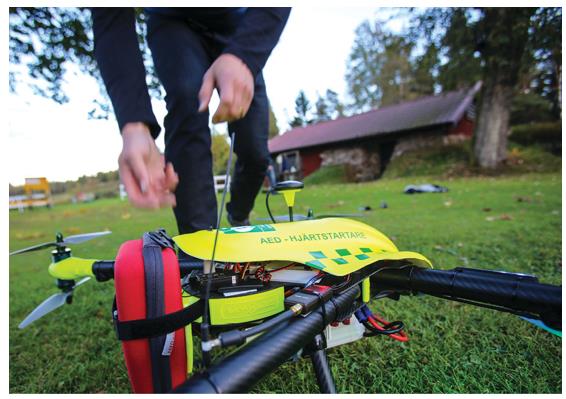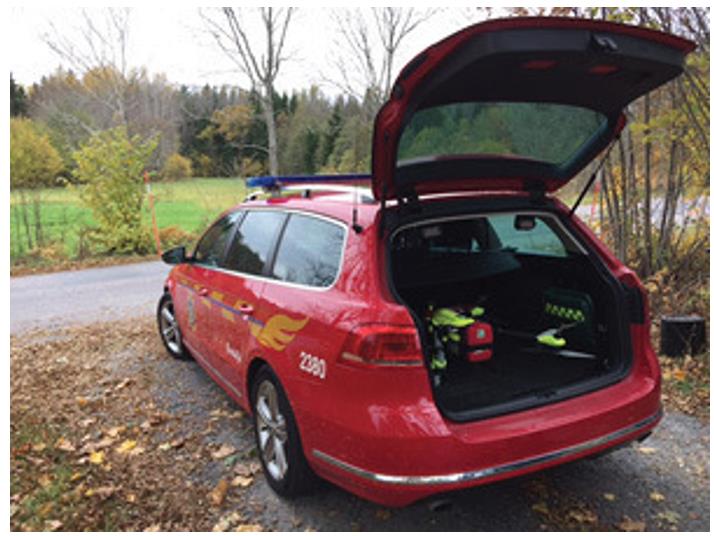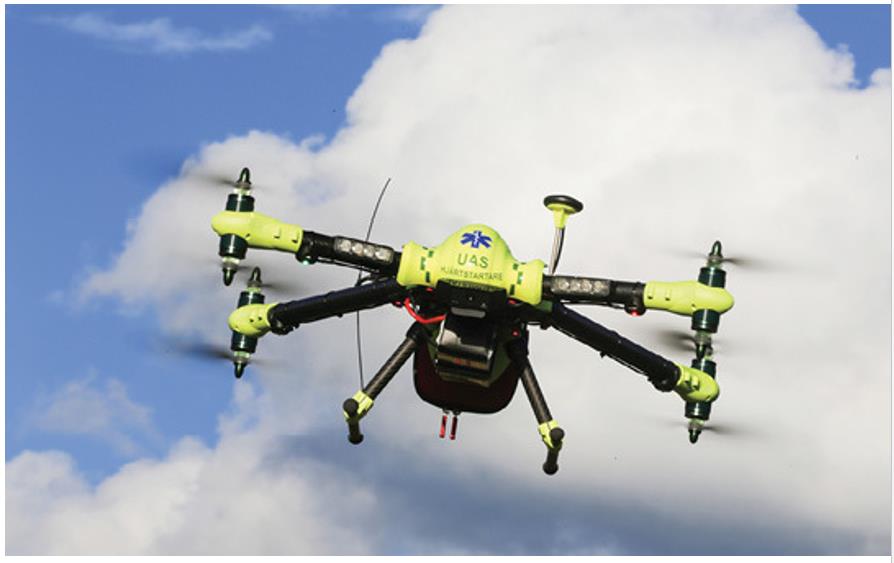Lifesaving Drones
Unmanned aerial vehicles for EMS & rescue applications
By Andreas Claesson, RN, EMT-P, PhD

Drone systems have a strong potential to facilitate lifesaving medical interventions, such as transporting and delivering an AED. Photos courtesy Andreas Claesson.
Out-of-hospital cardiac arrest (OHCA) affects nearly 360,000 individuals in the United States and about 300,000 in Europe each year. Survival rates are low.1,2
In Sweden, 5,312 OHCA cases were reported to the Swedish register for cardio-pulmonary resuscitation (SRCR) during 2016.3 CPR was initiated either spontaneously by bystanders, guided from the dispatch center through telephone CPR or on arrival of EMS, which took place after a median of 13 minutes from cardiac arrest.3
Overall 30-day survival was 11% (n = 577) and a majority of these (93%) had a favorable neurological outcome, with a cerebral performance category (CPC) score of 1–2.3
Time to treatment with a defibrillator is the single most important factor for survival, and each minute without CPR treatment decreases the chance of survival by 10%.4,5 Early use of a defibrillator within the first five minutes has a potential to save up to 50–70% of all patients suffering from an OHCA.6,7
Early CPR performed by bystanders, dual dispatch using firefighters and public access defibrillation programs (PADs) have been introduced in Stockholm County and have been shown to reduce time to defibrillation.6
These interventions have proven successful in both urban areas and in public locations, but despite EMS response time improving in rural areas of Stockholm County with dual-dispatch intervention, it had little or no effect on survival.8
A lot of effort is put in to PAD projects around the world, and there are a variety of systems for alerting bystanders of nearby AEDs, or other ways of dispatching AEDs to OHCA victims. However, AED usage in OHCA is still low in relation to the proportion of available AEDs.7
A novel way of decreasing the delay in remote areas with long EMS response times from collapse to first shock, may be to use an unmanned aerial vehicle (UAV—more commonly referred to as a “drone”) to quickly deliver an AED to bystanders.
Drones have been predicted to be increasingly used by EMS for delivery of medical products,9,10 however, regulations on limitations in wind, flight endurance and payload need to be developed in order to ensure drones are utilized safely.
STUDY DESIGN
In 2013, the Centre for Resuscitation Science at the Karolinska Institute in Sweden initiated a drone project, with the intent to reach victims of cardiac arrest in rural areas at an earlier stage.
Drone technology was evolving, and a methodology for facilitating early defibrillation with such a system had not yet been described in the literature. Neither EMS and first responders, nor volunteers via smartphones, could reach the victims in time.
A geographical information system (GIS) was used to predict optimal locations for drones equipped with AEDs in Stockholm County. In this deployment strategy, a total of 3,165 OHCAs occurring between 2006–2013 were analyzed by weighing OHCA incidence per 100,000 inhabitants and EMS response time.12
The GIS model predicted 20 optimal locations of drone placement (10 in urban areas and 10 in rural areas). The time savings in urban areas was estimated to 1.5 minutes, with the drone arriving before EMS in 32% of cases. However, in 124 cases of rural OHCA, the drone was calculated to arrive before EMS in 93% of cases, with a mean time savings of 19 minutes.12
The coastline and archipelago surrounding the city of Stockholm is heavily inhabited during summertime, with no additional EMS resources. EMS response time is prolonged in the area, especially on the islands where publicly accessible AEDs are rare. Similar GIS findings have been made in Canada and the U.S., supporting the benefits of providing such a model.13,14
Different AED delivery methods were tested, including landing the drone, parachute-release, and using a latch-release from a low altitude.

An AED-equipped drone can be deployed from dispatch within just three seconds and followed predefined flight corridors that would minimize disruption and risk to the community.
The latter two methods, however, introduced risks of imprecision and of damaging the defibrillator after dropping it onto the ground.
Following the explorative GIS data and the testing of AED deployment, researchers submitted applications to the transportation board to operate test flights where the drone could be seen within a pilot’s range of sight. These flights were planned over nine months, and the team focused on mapping the geographical area, predefining flight corridors so the drone flew above uninhabited areas, setting up routines and informing local authorities, EMS and members of the community.
Redundant communication systems and a high-quality video link within the 3G/4G network was used to remotely monitor and pilot the aircraft. With a daily notice to airmen, dispatch and flights based on historical OHCAs were performed in October 2016, with the results published in JAMA in June 2017.15
A local dispatch center was set up at a fire station within the proposed testing area in Norrtälje County, and direct communication with air traffic control was maintained during these short flights, which were operated at a median of five minutes at low altitude (100 meters) at a maximum distance of 9 kilometers.
Data showed that the drone could be deployed from dispatch within just three seconds, with a total median time savings of 16 minutes from dispatch to arrival onsite vs. EMS.15
The short delay for dispatch didn’t take into account time for uncovering the drone from its housing, an important factor to take into account when considering future integration into control structures.
All test flights followed predefined routes that ensured residential areas were geo-fenced, in order to minimize risks and disturbances in the community. Additional risk mitigation tactics included the use of redundant communication systems, return-to-home features and emergency controlled landing.
Even though straight flight lines seem intuitive, there are advantages in defining altitudes and flight corridors in order to minimize interference with other aircraft. Additionally, the use of radar or airborne collision avoidance systems are also advised. In order to arrive within 3–5 minutes after a cardiac arrest, early recognition at the dispatch center is crucial, followed by early dispatch of the drone and prompt flight times.
Although a battery-powered drone was used during the study, the size of the vehicle and the fuel used raised some questions. From the victim’s perspective, it doesn’t matter whether the drone weighs five or 100 kilograms. They don’t care where the drone gets its power to fuel operation (e.g., battery, hydrogen or jet fuel), as long as the response time is short and the AED is presented to a bystander in an intuitive way that minimizes the time to defibrillation.
After the drone has arrived on scenedeliver its AED, an EMS vehicle transports it back to its station.
In Stockholm, trained civilian “SMS lifesavers” have been strategically positioned throughout the service areas and dispatched using a smartphone app since 2015.16 These volunteers have the potential to be co-alerted to pick up an AED delivered by a drone, especially if the landing site is > 100 meters from the location.
Experience shows that there’s risk involved in landing the drone in a public space. The drone’s lights, siren and engine noise tends to attract attention, and its still-rotating propellers can present a danger.
It’s believed that by using a winch in the future to lower the AED may promote safer delivery to bystanders, EMS or other first responders who are on site.
Communications with the drone may also improve when the drone is elevated, instead of hidden behind obstacles such as houses or hills. This will also conserve battery power/fuel so that the drone can still return to base if landing isn’t feasible.
Important questions have been raised regarding the feasibility of implementation at the community level and there may be many challenges.17
Although regulations differ in various countries, aviation legislation is similar across all high-income countries, with regulations focusing on safety for people on the ground as well as those in manned aircraft.
Drone technology is already at a level to facilitate early defibrillation in OHCA. However, there are several considerations and questions that must be asked in order to take a structured approach to evaluating all the links in the chain of drone deployment.
If not planned properly, integration of drones at the dispatch center could delay traditional EMS response or dispatcher-assisted CPR.
In addition, arrival of the drone on scene may cause prolonged hands-off intervals, as the bystander waits for the drone vs. performing high-quality CPR.
Designing an AED drone system for use in real-life OHCA cases is complex, requiring interaction of technology, regulations, bystanders and EMS control structures. Each area or region considering drone delivery of AEDs will need thorough testing in order to facilitate safe arrival of the drone and actual use of the AED during the first minutes of an OHCA.
DRONES FOR DROWNING
At the same time our researchers were studying drone delivery of AEDs on land, AED-equipped drones were also deployed for several historical drowning incidents of OHCA that occurred at Tylösand public beach, where the victims were discovered too late in the drowning process.
Tylösand is visited by nearly 50,000 bathers on a sunny summer day, with strong rip currents present in high wind conditions.
Off-the-shelf drones (specifically, the DJI Phantom 4) were tested in simulated settings to determine whether the drones could successfully send live video from an altitude of 60 meters down to rescuers using a tablet to watch the video and quickly locate submerged victims.18
The first drones for search and rescue purposes in Scandinavia were implemented in June 2017 at Tylösand surf-lifesaving club.
In addition to providing situational awareness and facilitating early positioning of submerged individuals, there are future possibilities of providing early flotation to drowning victims by dropping self-inflatable buoys.
The drones may also see future use for ice rescue, with the drones delivering buoyancy and lines to victims trapped in breaking ice. Testing this concept is already underway in the Göteborg area.
Regulations regarding flight conditions, endurance and payload need to be developed in order to ensure drones are utilized safely.
CONCLUSION
Drone systems have a strong potential to facilitate lifesaving medical interventions, such as transporting and delivering an AED in cases of OHCA. Our three-year vision is to implement a drone system that will autonomously dispatch to OHCA patients in suitable areas, defined by current regulations in the jurisdiction, controlled airspace considerations, and other factors associated with air traffic security.
We would like to encourage fire departments and EMS systems worldwide to learn more about the potential of deploying drone technology for both OHCA and water lifesaving purposes.
Andreas Claesson, RN, EMT-P, PhD, is a registered nurse and paramedic in Western Sweden. He also holds a post-doctorate research position at the Centre for Resuscitation Science at the Karolinska Institute in Stockholm, where he focuses on innovative methods for early defibrillation for patients in cardiac arrest. This includes SMS-lifesaving dispatching of laymen and the use of unmanned aerial vehicles (i.e., drones) for delivery of AEDs in rural or hard-to-serve areas. He’s the chair of the Swedish resuscitation council, a position he’s held since 2017. He can be reached at andreas.claesson@ki.se.
REFERENCES
1. Mozaffarian D, Benjamin EJ, Go AS, et al. Executive summary: Heart disease and stroke statistics—2016 update: A report from the American Heart Association. Circulation. 2016;133(4):447–454.
2. Atwood C, Eisenberg MS, Herlitz J, et al. Incidence of EMS-treated out-of-hospital cardiac arrest in Europe. Resuscitation. 2005;67(1):75–80.
3. Swedish CPR Council. (2017.) Annual report 2017. Retrieved Dec. 7, 2017, from www.hlr.nu/hjart-lungraddningsregistret/.
4. Valenzuela TD, Roe DJ, Cretin S, et al. Estimating effectiveness of cardiac arrest interventions: a logistic regression survival model. Circulation. 1997;96(10):3308–3313.
5. Waalewijn RA, de Vos R, Tijssen JG, et al. Survival models for out-of-hospital cardiopulmonary resuscitation from the perspectives of the bystander, the first responder, and the paramedic. Resuscitation. 2001;51(2):113–122.
6. Valenzuela TD, Roe DJ, Nichol G, et al. Outcomes of rapid defibrillation by security officers after cardiac arrest in casinos. N Engl J Med. 2000;343(17):1206–1209.
7. Ringh M, Jonsson M, Nordberg P, et al. Survival after public access eefibrillation in Stockholm, Sweden: A striking success. Resuscitation. 2015;91:1–7.
8. Nordberg P, Jonsson M, Forsberg S, et al. The survival benefit of dual dispatch of EMS and fire-fighters in out-of-hospital cardiac arrest may differ depending on population density—A prospective cohort study. Resuscitation. 2015 May;90:143–149.
9. Floreano D, Wood RJ. Science, technology and the future of small autonomous drones. Nature. 2015;521(7553):460–466.
10. Thiels CA, Aho JM, Zietlow SP, et al. Use of unmanned aerial vehicles for medical product transport. Air Med J. 2015;34(2):104–108.
11. Abrahamsen HB. A remotely piloted aircraft system in major incident management: Concept and pilot, feasibility study. BMC Emerg Med. 2015;15:12.
12. Claesson A, Fredman D, Svensson L, et al. Unmanned aerial vehicles (drones) in out-of-hospital-cardiac-arrest. Scand J Trauma Resusc Emerg Med. 2016;24(1):124.
13. Boutilier JJ, Brooks SC, Janmohamed A, et al. Optimizing a drone network to deliver automated external defibrillators. Circulation. 2017;135(25):2454–2465.
14. Pulver A, Wei R, Mann C. Locating AED enabled medical drones to enhance cardiac arrest response times. Prehosp Emerg Care. 2016;20(3):378–389.
15. Claesson A, Bäckman A, Ringh M, et al. Time to delivery of an automated external defibrillator using a drone for simulated out-of-hospital cardiac arrests vs emergency medical services. JAMA. 2017;317(22):2332–2334.
16. Ringh M, Rosenqvist M, Hollenberg J, et al. Mobile-phone dispatch of laypersons for CPR in out-of-hospital cardiac arrest. N Engl J Med. 2015;372(24):2316–2325.
17. Mark DB, Hansen SM, Starks ML, et al. Drone-based automatic external defibrillators for sudden death? Do we need more courage or more serenity? Circulation. 2017;135(25):2466–2469.
18. Claesson A, Svensson L, Nordberg P, et al. Drones may be used to save lives in out of hospital cardiac arrest due to drowning. Resuscitation. 2017;114:152–156.








